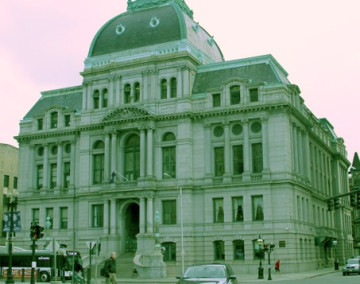EXCLUSIVE: Providence Unfunded Pension Liability Now At Least $831M
Thursday, February 06, 2014
With a system that is 31.3 percent funded and an unfunded liability of $831.5 million, Providence’s pension crisis is far from over according to a new actuarial report obtained by GoLocalProv.
The Jan. 31 report offers the first glimpse of the Providence retirement system in the wake of the city’s pension reform settlement with retirees, which was finalized last year. Prior to the settlement, the unfunded pension liability stood at $901 million, in July 2011. Without reform, the city actuary says the unfunded liability would now be $964.7 million, instead of $831.5 million.
But the funding ratio for the system actually edged downwards during the intervening two years, from 31.94 percent in July 2011 to 31.39 percent in July 2013. However, on a market value basis it increased from 31.4 percent to 32.4 percent. (See below slides for a breakdown of the numbers.)
GET THE LATEST BREAKING NEWS HERE -- SIGN UP FOR GOLOCAL FREE DAILY EBLASTImpact of pension reform disputed
“So even under the most optimistic analysis of the numbers and using the ‘market value’ of the assets, Providence’s pension fund is 32 percent funded? Find an honest expert who would describe this as remotely sound or healthy. The Taveras administration trumpets the $133 million saved by pension reform but is considerably more muted about the far more important fact that the pension system is still only 32 percent funded—to repeat, only 32 percent funded after pension reform,” said Monique Chartier, spokeswoman for the Rhode Island Taxpayers.
Providence owes $1.2 billion in pension promises and the system has $380.4 million in actuarial assets. But that actuarial estimate includes $57.2 million in contributions from the city for the following year. If future contributions are not included—as the actuary recommends in its report—the fund has a market value of $335.7 million. When actuarial adjustments are made for market losses, the amount drops further to $323.4 million, making the system 24.1 percent funded.
“Taking baby steps to turn the capital city’s woefully underfunded pension plan around may make for great sound bites in an election year but the numbers reveal that residents and all Rhode Islanders have grave reason to be scared, very scared about our economic well-being. Any suggestion that Providence is on its way to substantial financial recovery is simply not accurate,” said Lisa Blais, spokeswoman for the OSTPA, a taxpayer advocate.
Blais noted that the unfunded liability estimate does not—as a result of local bargaining—include the liabilities that the city has incurred for retiree health benefits.
“That number skyrockets us into the realm of debt in the billions,” Blais said. “While it’s appropriate to provide the proverbial tip of the hat to the people at the negotiating table who had a hand in slowing down the COLA payments and changing the way that they were formerly calculated, it is important to remember that the original local agreements were negotiated by some of the same players.”
Those involved in the city pension reform effort pointed to the latest report as an encouraging sign.
While the drop in the unfunded liability may not seem “remarkable,” Paul Doughty, the city firefighter union president described it as a “first good step” towards a healthy funded pension system. Michael Solomon, the city council president and also a candidate for mayor, touted the achievements of the pension reform settlement. He said the city must now focus on making its annual required contributions. (A spokesman for Mayor Angel Taveras did not respond to a request for comment. All major mayoral candidates responded to requests for comment. Their responses are below.)
Pension critic says unfunded liability could be over $1 billion
But some say the city may actually be understating the extent of its unfunded liability.
For one thing, the city is overstating its current assets by about $57 million because its estimates include its contributions to the pension fund in the following year, noted Michael Riley, a local private equity and hedge fund investment manager, who noted the actuary recommends the city discontinue the practice. “This is a highly unusual tactic distorting assets,” said Riley, who is also a GoLocalProv columnist.
Asked to comment, Solomon said, “We received this report yesterday. The city council will openly and directly review the pros and cons of making any recommended reporting changes.”
A larger issue is the assumed rate of return for the city’s pension investments. Before 2011, the city had an assumed rate of return of 8.5 percent. When the city dropped that by a quarter of a point to 8.25 percent, the unfunded liability jumped up by $72 million.
Riley and others say the assumed rate of return should be even lower. The city rate is still higher than the state’s, which, at the behest of state Treasurer Gina Raimondo, lowered its assumed rate of return from 8.25 percent to 7.5 percent in 2011. Some investment experts recommend an even lower rate. Moody’s Investors Service recommends 5.5 percent. Investor Warren Buffet has suggested 6 percent.
Using Moody’s guidelines, Riley says the total liability would shoot up from $1.2 billion to $1.6 billion. That would make the unfunded liability about $1.3 billion, roughly $500 million more than the official estimate.
“All of this calls into question the accuracy of the term ‘pension reform.’ The word ‘reform’ implies that the pension system is now in a reasonably sound condition. Clearly, the opposite is true,” Chartier said.
“Unlike his predecessor, Mayor Angel Taveras is a genuinely nice man who means well. However, his touting pension ‘reform’ as a fiscal achievement for the city begins to stray into the area of dishonesty notoriously frequented by his predecessor. Former Mayor David Cicilline repeatedly misrepresented as ‘excellent’ the overall financial condition of the city,” Chartier added. “Current Mayor Taveras is telling only one small part of the story about the financial condition of the city’s pension system—and doing so for the same reason, presumably, as the prior mayor: the desire for a ‘promotion’ to higher office. Mayor Taveras did not create the city’s very serious pension problems but neither, contrary to his implications, has he solved them.”
Firefighter union president defends city assumptions
Doughty, however, said those, like Moody’s Investors Service, which argue for a lower assumed rate of return are not disinterested parties. Doughty noted that financial institutions make money every time a transaction is made (like an investment). A lower rate would dramatically increase estimates of the unfunded liability, Doughty said: “The calculation at that point is the fund is much more—much more—unfunded.”
Higher estimates for an unfunded pension liability becomes an impetus for further pension reform, potentially including the creation of individual retirement accounts, instead of (or addition to) one pension fund with contributions from all workers pooled together, Doughty suggested. When financial institutions are processing transactions for thousands of workers, rather than just city, they stand to make more money, he concluded.
“To me there’s a conflict [of interest] there in what they’re saying,” Doughty said. “I’m not a fan of Wall Street. This is just a money grab.”
Doughty acknowledged that elected officials may be acting out of self-interest as well, aiming to keep estimates of unfunded pensions liabilities lower than they actually are. “Very true. I think there’s a tension there,” Doughty said.
But he said the political risk can go both ways for an elected official. Those who adopt the approach of Moody’s and lower their assumed rates of return are increasing costs for their communities and crowding out funding for bread-and-butter city projects, like re-paving sidewalks or building new playgrounds, according to Doughty.
When it comes to Providence, he said he stands by the current assumed rate of return of 8.25 percent that city officials have adopted. “I think somewhere in the 8s is fair,” Doughty said.
Candidates for mayor weigh in
GoLocalProv requested comment from every major mayoral campaign in Providence. All responded except for the sole GOP contender, Dan Harrop.
Two candidates, Brett Smiley, the former chairman of the Providence Water Supply Board, and Jorge Elorza, a former city housing court judge, emphasized the need to expand the tax base by attracting businesses to Providence.
“Those who have served the city deserve to retire with dignity. The top priority for our city needs to be growing our economy by investing in our strengths and supporting our business community so that we can have enough funds to meet our future pension obligations. That’s why we need a Mayor with the practical experience to hit the ground running and begin to strengthen our city's finances from Day One,” Smiley said in a statement.
Said Elorza: “We have a commitment to both our retirees and our children that must be honored, and it is equally important that we pay our bills and not lose sight of current responsibilities. The unfunded liability is down $70 million. As Mayor, I will accomplish both and continue to decrease that number by focusing on revitalizing our economy and continuing to look for savings to ensure our city can fulfill its obligation to both its retirees and residents.”
Asked if the most recent pension reform was enough to fix the system, Solomon touted its achievements: “Two years ago we reached a landmark settlement with our retirees and employees to reduce the unfunded liability by nearly 20 percent. We suspended COLAs for 10 years and finally eliminated the 5 and 6 percent COLAs that had haunted the city, and tied future COLAs to the consumer price index. These changes were fair, especially considering the city’s bargaining position. The most important thing we can do moving forward is to fully fund our annual required contribution.”
Solomon also defended the city on the assumed rate of return.
“Buck Consultants, the city’s former actuary, conducted an experience study in June, 2011 that forecasted 1,000 return scenarios. They determined that an 8.45 percent return over the next 30 years was likely. They wrote, ‘We believe the current 8.25 percent interest rate assumption can be supported based on our analysis assuming the target asset allocation continues, the assets earn the assumed rate of return and the City makes the recommended contributions,’” Solomon said in a statement provided by his campaign.
However, one candidate for mayor, businessman Lorne Adrain, disagrees. He says the city should lower its assumption. “This report shows the long-term consequences of short-term thinking. For too many years the City of Providence underfunded its pension system at the expense of retirees and future generations of taxpayers. As Mayor I will develop a transparent and balanced approach to solving the problem. I will make fiscal responsibility a top priority, including a more realistic, achievable return rate of between 5 to 6 percent,” Adrain said.
Unfunded liability: Providence on a 30-year payment plan
For now, regardless of whether how one views the $831.5 million unfunded liability the question remains: how will the city pay for it?
“The city’s funding policy is to make a payment each year which covers that year’s normal cost plus a payment toward the unfunded liability. The payments toward the unfunded liability will reduce the unfunded liability to $0 by June 30, 2040 in payments that increase 3.5 percent per year,” said Matt Clarkin, the internal auditor for the city.
The pension report shows that Providence is in the midst of decades-long amortization plan. Because of the unfunded liability, the report shows that the annual payments will increase dramatically in the future. The city’s contribution in the current fiscal year is set at $61.6 million.
Although annual increases are meant to be capped at 3.5 percent, the amount for fiscal year 2015 will be 8 percent higher—at $66.5 million—to account for the investment losses in 2009. Presumably, the city should have already paid for some of those, but it didn’t because it did not have a 2012 valuation of its pension system. (The last one was 2011. The new one is for 2013.)
“The 2012 report was not issued because the city was in the process of soliciting bids for a new actuary. The city does an annual valuation, but it is not uncommon for public sector retirement systems to perform biennial valuations,” Clarkin said. (The city is in the process of suing its former actuary, Buck Consultants, accusing the firm of an error in calculating savings from pension reform.)
Ten years from now, the normal cost of maintain pension benefits would be $9.8 million, but the total cost to the city will be $94.3 million because of the unfunded pension liability. In another decade, the normal cost would have been $13.9 million but the actual cost will be $132.4 million, according to the report.
It won’t be until June 30, 2040 that the entire unfunded liability is paid off, according to Clarkin.
“The Segal Consulting analysis shows the necessity for taxpayer contributions to rise inexorably year over year. In light of the fact that Providence already has the highest commercial tax rate and the seventh highest residential tax rate in the country, where in the world can this money come from? Business and residential taxpayers are demonstrably tapped out. Decades of extremely generous pensions have left the city with a staggering and completely unrealistic burden,” Chartier said.
Doughty doesn’t share that same sense of alarm but he said he considers all the attention that public pensions are getting to be “positive,” saying it’s a welcome change from the many years when pension reports went ignored. “The more attention you pay, the less shenanigans can go on,” Doughty said.
Stephen Beale can be reached at [email protected]. Follow him on Twitter @bealenews
Related Slideshow: Providence Pension Liability
A new report shows that Providence’s pension fund—even after the recent reform—is still in trouble. The below slides break out the key numbers for the pension fund, including the unfunded liability, the assumed and actual rates of return, the current level of benefits, and how long it will take the city to pay off the unfunded liability. Figures are current as of July 1, 2013 and are taken from the new Jan. 31 actuarial report from Segal Consulting.
Related Files
Related Articles
- EXCLUSIVE: Providence Pensions—Costs to Triple in 20 Years
- NEW: EngageRI Supports Providence Pension Reform
- NEW: Hassett and Igliozzi Call for Changes to Providence Pension Reform
- NEW: Taft-Carter rules Providence Pension Changes “Fair”
- Providence Pension Projection Data Raising Questions
- Providence Pension Return Projection Flawed
- Rob Horowitz: Providence Pension Deal Provides Model for All Communities



















2013.png)
.png)













2013_80_80_c1.png)
_80_80_c1.png)



